| Pieces of France
By Mike Bennighof, Ph.D.
September 2023
.jpg) Panzer Grenadier: 1940 The Fall of France includes 660 game pieces, eight geomorphic mapboards and 50 scenarios. We know the deepest secret of Panzer Grenadier players: It’s all about the toys! So what can you expect in your game box? Here’s a look: Panzer Grenadier: 1940 The Fall of France includes 660 game pieces, eight geomorphic mapboards and 50 scenarios. We know the deepest secret of Panzer Grenadier players: It’s all about the toys! So what can you expect in your game box? Here’s a look:
A Pied
French infantry platoons are slightly smaller than those of the Germans, as the French divided their rifle companies into four platoons instead of three. Most riflemen carried the Berthier 07/15 “Fusil 1916,” an 8mm weapon that their fathers took into the trenches of the Great War. Troops disliked its poor accuracy and found its length unwieldy — it had been designed to extend the reach of its bayonet. A few units still carried the Lebel Model 1886, a bolt-action rifle with an archaic tube magazine, which continued in production until 1920. A new rifle, the MAS36, began to slowly filter to first-line units in 1936. This weapon fired the same 7.5mm round as the FM24/29 light machine gun issued to each infantry squad. A semi-automatic version, the MAS38, had been tested but not accepted for service; in a modified version as the MAS49 it would become the French Army’s standard weapon during the Cold War.
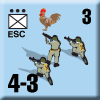  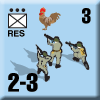 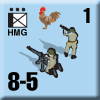
In the game, French infantry come in three flavors. ESC or “Escadron” units represent the army’s elite — the motorized infantry of the armored and mechanized divisions, and other elite units. They have fewer men per platoon, but two light machine guns per squad instead of one. INF are the standard infantry, while RES are the reservists of the Series B divisions who went to war with a marked lack of enthusiasm. These last did not always have a modern light machine gun, and some even went to war with the useless Chauchat of the Great War.
A French heavy machine gun platoon had four Hotchkiss M1914 machine guns, with four platoons in the battalion’s machine gun company. This was an outdated weapon, and very heavy compared to other armies’ machine guns. Thus the French HMG platoons have a movement allowance of only 1, compared to 2 for every other similar unit in the Panzer Grenadier series.
Mobile Troops
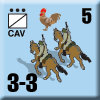 
France mobilized three cavalry divisions at the start of the war, and had expanded to five by the time of the 1940 campaign. While French theory looked to mechanized forces as the future of warfare, some traditionalists argued that horsed units could still play a vital role in broken terrain like that of the Ardennes. All five divisions, plus three independent brigades, fought there in 1940.
Horsed cavalry made up one of the division’s two brigades, with the other consisting of motorized infantry and light tanks. The horsemen were armed similarly to the infantry, with Berthier carbines rather than rifles, and fewer FM24/29 light machine guns. Each squadron had four platoons, and each regiment had five squadrons, making it about the size of a reinforced infantry battalion.
Like the Germans, the French deployed motorcycle troops both for scouting purposes and for their relative mobility. The French motorcycle platoon (usually called dragons portes) had two light machine guns, just like the elite infantry and these were considered elite troops.
Anti-Tank Weapons
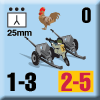 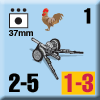 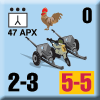
The French Army accepted the 25mm Hotchkiss model M34 in 1934, after eight years of testing. It had effective penetration for the time, and a very good flash suppressor. The Hotchkiss weapon replaced the Great War-era 37mm infantry gun, that had also been deployed in the anti-tank role and remained in service with many units in 1940.
Heavy tanks had been deployed by the French during the First World War, and they fully expected to meet them on a future battlefield. That required a heavy anti-tank gun — controlled by the artillery rather than the infantry — to supplement the 25mm Hotchkiss. In the 1920s, 75mm M1897 guns filled that role, but they were not mobile enough for the anti-tank tactics developed by the French and requirements went out for a smaller, lighter weapon with at least the same penetration and range.
Atelier de Puteaux (APX) produced a 47mm gun in 1937 that met these needs, but the French Army was slow to order them — with thousands of M1897 field guns in the arsenals, politicians questioned why they were spending large sums on new weapons at the height of the Great Depression (which struck France later than it did most other countries, and hung around longer as a result).
Only small numbers of the new gun were fielded in 1940, and they proved extremely effective. The high-explosive round was in short supply, but for anti-tank work the gun had a deadly tungsten-cored round that could penetrate any tank the panzer divisions fielded in the French campaign.
Artillery
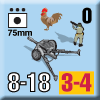  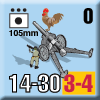
The artillery’s backbone in 1940 remained the famed “French 75,” with over 4,500 in action. A revolutionary weapon when new, its prime had long passed. French planners were well aware of this weakness, but had trained thousands of reservist artillerymen in its use and balked at the task and expense of instructing them all over again on new pieces.
Nevertheless, a large faction in the French high command hoped to replace their 75mm light artillery with new 105mm weapons, the same caliber chosen by the Germans and Americans for this role. Schneider produced three different models, all of which were in service in 1940. Their performance was very similar in game terms.
The big 155mm GPF rifle equipped heavy artillery battalions in the French Army, and in the United States and Romania as well.
Support Weapons
  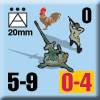
France produced the famed 81mm Brandt mortar, copied by most combatants in World War II. Infantry battalions all had a mortar section for support. Its smaller sibling, the 60mm mortar, appeared in heavy weapons companies and as with 50mm and 60mm weapons of other nations is folded into the firepower of the HMG units. However, some French units (such as the cavalry) fielded platoons of 60mm mortars and so they appear in the game with their own pieces.
French anti-aircraft weaponry was lacking in 1940; the French had rejected a 25mm design by Hotchkiss in 1938 but reversed course when Schneider could not finish development of a 37mm gun in time. Several hundred 25mm guns had been produced by 1940, and the French supplemented them by purchasing 20mm Oerlikon and Hispano-Suiza weapons.
For the heavy anti-aircraft role, the French still relied on 75mm guns of World War One vintage. These remained surprisingly effective in 1940, considering their age, and were equipped for indirect fire.
And Next Time ...
Tanks. Lots and lots of tanks. If you play this game for the tanks, you have to have 1940.
You can order 1940: The Fall of France right here.
La Campagne 1940
1940: Road to Dunkirk (boxed)
1940: The Fall of France (Playbook ed)
1940: Swallows of Death
1940: The Last Days of May
1940: Polish Exiles
Retail Price: $267.95
Package Price: $215
Gold Club Price: $172
You can order La Campagne 1940 right here.
Sign up for our newsletter right here. Your info will never be sold or transferred; we'll just use it to update you on new games and new offers.
Mike Bennighof is president of Avalanche Press and holds a doctorate in history from Emory University. A Fulbright Scholar and NASA Journalist in Space finalist, he has published a great many books, games and articles on historical subjects; people are saying that some of them are actually good.
He lives in Birmingham, Alabama with his wife and three children. He misses his Iron Dog, Leopold.
Want to keep Daily Content free of third-party ads? You can send us some love (and cash) through this link right here.
|
